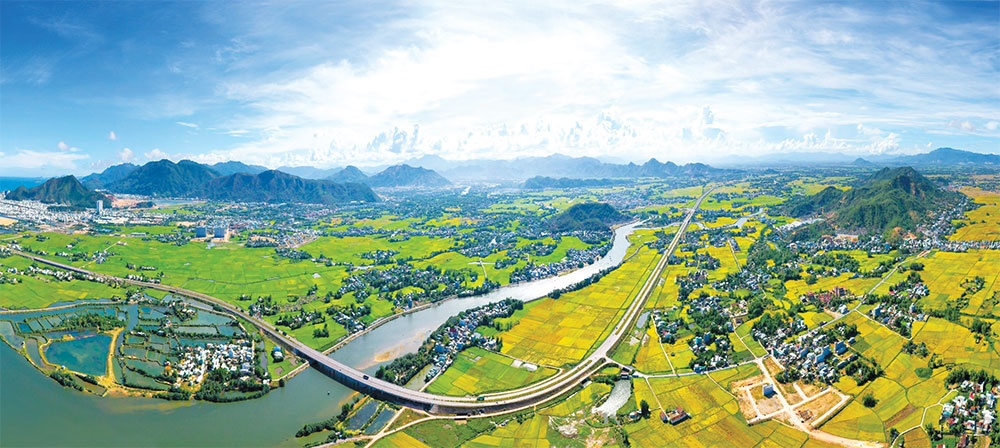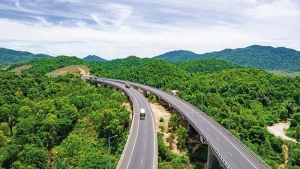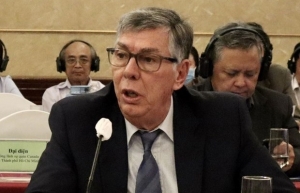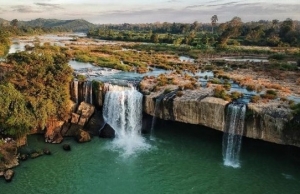Infrastructure rejuvenation to light up Central Highlands
The Central Highlands is considered a strategic region, playing an important role in Vietnam’s political and economic development. That is why, in recent years, the Party and the government have paid special attention to the region. With that, many important incentives and supported policies have been issued to boost the Central Highlands and make breakthrough changes.
 |
| Infrastructure rejuvenation to light up Central Highlands |
According to the Ministry of Transport (MoT), the total capital required for transport infrastructure in the region this decade is around VND156 trillion ($6.6 billion).
Besides upgrading current national highways, the MoT will coordinate with relevant agencies to mobilise financing to invest in a modern highway system with higher capacity and speed to connect the Central Highlands with the south-central coast provinces and the entire development triangle area of Vietnam, Laos, and Cambodia.
Accordingly, the government assigned around VND11.7 trillion ($490 million) for 2021-2025 to localities in the Central Highlands to implement targeted programmes to double the average income of tribal people, and reduce poverty in over 60 per cent of underprivileged communes and villages.
Up to now, the economic scale of the region has increased rapidly, more than 14 times higher than in 2002 and 3.1 times higher than in 2010. The average growth rate of regional GDP is nearly 8 per cent per year, the growth rates of all economic sectors are the highest compared to other regions. Regional GDP per capita reached over VND48 million ($2,000), over 10 times higher than in 2002.
To boost socioeconomic development in the Central Highlands region, last year the Politburo issued Resolution No.23-NQ/TW. In terms of economic development, the resolution requires accelerating regional economic growth, taking agricultural and forestry development as the focus and the mainstay; processing industry development as a driving force; and improving tourism development.
Party General Secretary Nguyen Phu Trong said that the resolution has inherited previous resolution viewpoints and is consistent with the new context and situation.
“The Central Highlands region has a particularly important strategic role. Rapid and sustainable development of the Central Highlands is a major policy of the Party and the state, and is a central, cross-cutting task with important significance for the development of localities in the region and the whole country,” General Secretary Trong said.
The goal is that by 2030 with a vision to 2045, the Central Highlands will become a region of sustainable development, with a green and circular economy.
A global approach
At the end of 2022, Prime Minister Pham Minh Chinh pointed out the reasons why the region has not developed as planned so far: underdeveloped infrastructure, especially in transportation, healthcare, and education. The Central Highlands also lacks both human resources and financial resources.
“Recently, the Central Highlands has mainly relied on state investment resources, but resources from businesses and investors are still limited,” PM Chinh said.
In addition, the lack of intra-regional, inter-regional, and international connectivity is also why the region’s development is inadequate to its potential. Along with that, it has not yet built up national and international brands.
According to the PM’s direction, the Central Highlands must be self-reliant, using internal resources as the fulcrum and external resources as the breakthrough. At the same time, taking people and businesses as the centre and driving force for development.
“There must be a global, all-people approach to development,” the prime minister said. “The Central Highlands must develop breakthroughs, covering all subjects and industries, developing comprehensively but must be sustainable. The gap between rich and poor must be narrowed, ensuring social security and leaving no-one behind.”
The Central Highlands has set 20 specific socioeconomic and environmental targets to strive to achieve by 2030. Among them, there are a number of important targets - for example, the average growth in 2021-2030 will reach about 7-7.5 per cent; and regional GDP per capita reaches about VND130 million ($5,500) per year.
The action programme has also set out 23 specific tasks and nine connected transport infrastructure and projects and assigned them to ministries, branches, and localities to implement, with a specific timeline.
Now, many important transportation projects have been activated. The most prominent of which are horizontal transport projects connecting the Central Highlands provinces with the delta.
Several months ago, Dak Lak People’s Committee coordinated with the MoT to start construction on Khanh Hoa-Buon Ma Thuot Expressway. Phase 1 of the project has a total length of about 117.5km, with total investment for all phases coming to nearly $928 million.
Chairman of Dak Lak People’s Committee Pham Ngoc Nghi said that the project has strategic significance to importantly contribute to strengthening the region’s economic and social development, ensuring national defence and security.
Lam Dong province is boosting the Tan Phu-Bao Loc Expressway project and wants to launch it imminently. The project has a length of about 66km and costs around VND17 trillion ($726 million).
Similarly, the Bao Loc-Lien Khuong section, running 74km long and costing more than VND19 trillion ($800 million) is also being urgently promoted by the province to launch construction in early 2024.
The Gia Nghia (Dak Nong province) to Chon Thanh (Binh Phuoc province) Expressway project was also approved in June, in the form of a public-private partnership (PPP). The project has a length of about 127km and belongs to the western portion of the North-South Expressway project. It will likely cost over VND26 trillion ($1 billion).
Le Trong Yen, Deputy Chairman of Dak Nong People’s Committee, said, “Gia Nghia-Chon Thanh Expressway is an urgent project and a lever to develop the province’s aluminum industry, high-tech agriculture, and tourism. Besides that, the project also contributes to linking the strengths of the Central Highlands with the southeast region and Ho Chi Minh City, creating a breakthrough for the province to develop fast and sustainably.”
 |
Coordinating to improve
Also related to investment in the roads connecting the Central Highlands, the draft planning of Danang also proposes to add the expressway connecting Danang, Thach My, Ngoc Hoi, and Bo Y into planning for the period after 2030.
Previously, the MoT sent a document to the people’s committees of Quang Ngai and Kon Tum provinces on supplementing the Quang Ngai-Kon Tum Expressway planning. This will eventually connect the two through National Highway No.24, Quang Ngai-Quang Nam and Danang-Ngoc Hoi expressways.
In addition to the above routes, Binh Dinh province has also been promoting investment in a highway connecting its Quy Nhon city with Gia Lai province. This project is not only an important trade door for the entire Central Highlands, but also further out to Cambodia and Laos.
Meanwhile, Ninh Thuan coordinated with Lam Dong province last year to propose restoring the Thap Cham-Dalat railway. This project was proposed by Bach Dang Hotel Service and Trading JSC with a total capital of VND25 trillion ($1.05 billion). This enterprise has submitted a pre-feasibility study report to the MoT for the project in the form of a PPP.
The railway would pass through Phan Rang city of Ninh Thuan province and Don Duong district of Dalat, and would be over 83km long. It is expected to have 16 stations and use diesel locomotives as well as light-duty carriages.
The project includes restoring or building 64 bridges, five tunnels, 11 stations, and building upper structures. Secondly would come an upgrade of the route from Trai Mat station to Dalat Station, which is currently already in operation, followed by restoring and preserving Dalat and Trai Mat stations.
 | Huge transport investment expected to vitalise central regions More than $4.34 billion are to be put into expanding the national highway network from 2021 to 2025, which is expected to create a turnaround to transport infrastructure development in the central regions. |
 | European firms interested in various sectors in Central Highlands: EuroCham leader Tourism, agriculture, and renewable energy, which have high potential in the Central Highlands, are sectors that European enterprises are interested in, said Alain Cany, President of the European Chamber of Commerce in Vietnam (EuroCham). |
 | Central Highlands urged to “awaken” tourism potential The Central Highlands region boasts huge potential for tourism development; however, the regional non-smoke industry has to date failed to unlock its potential and strengths. |
What the stars mean:
★ Poor ★ ★ Promising ★★★ Good ★★★★ Very good ★★★★★ Exceptional
Related Contents
Latest News
More News
- Sembcorp Development secures licence for VSIP in Khanh Hoa (December 31, 2025 | 18:54)
- New decree sharpens enforcement in securities market (December 31, 2025 | 18:53)
- Green transition to close $20 billion annual investment gap (December 31, 2025 | 11:59)
- FPT exports first chip shipment to Japan (December 31, 2025 | 10:47)
- AkzoNobel rolls out sustainability campaign “It All Adds Up” for the wood sector (December 31, 2025 | 09:23)
- Gold market reform advances as SBV receives applications for bullion production (December 30, 2025 | 12:07)
- T&T Group brings Savan 1 Wind Power Plant online in Laos (December 30, 2025 | 12:05)
- Australia contributing to Vietnam’s climate change responses (December 30, 2025 | 11:37)
- CME Solar strengthens position in Vietnamese renewables (December 30, 2025 | 11:21)
- Textile apparel firms deliver robust earnings despite global tariff pressures (December 30, 2025 | 10:09)

 Tag:
Tag:





















 Mobile Version
Mobile Version